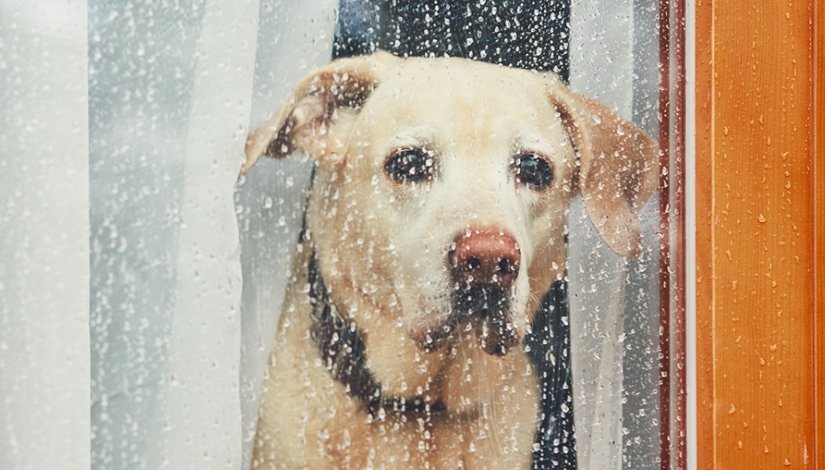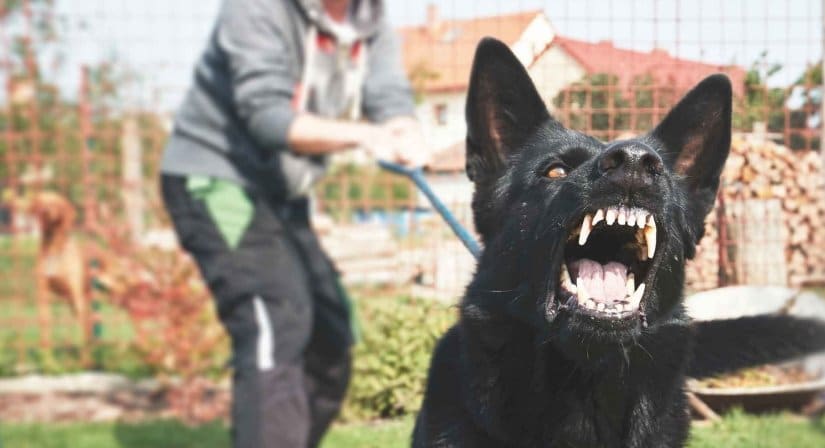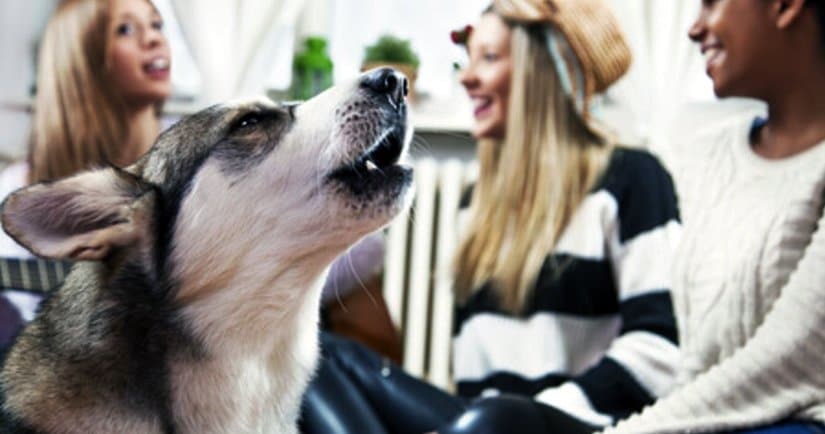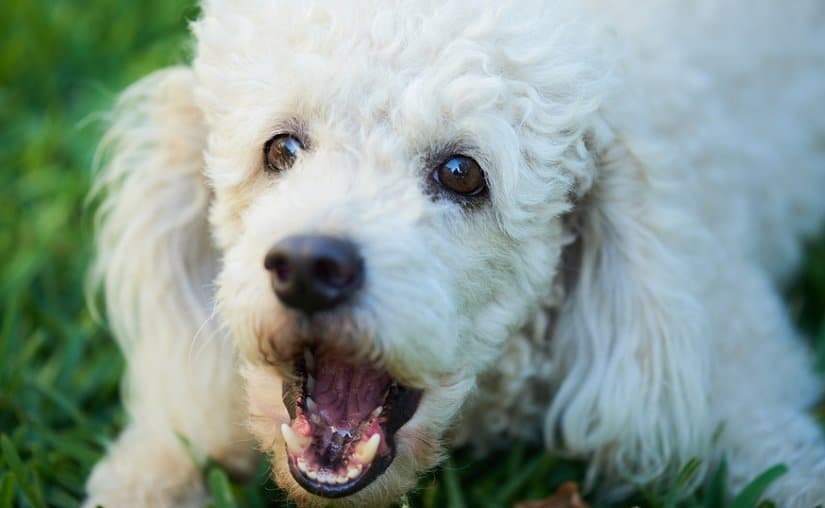All dogs communicate with the world around them, just like humans do. They do this in many different ways. Canine communication is important to understand because dogs vocalize by barking, growling and whining. A common problem that pet parents have to deal with is excessive barking in dogs that bark at visitors and guests.
How to Train Your Dog to Stop Barking Excessively? This is a guide on how to teach your dog to stop barking excessively at visitors, and while he’s at home if he’s alone or with you.
When dogs bark excessively, it can be annoying, but before we can stop excessive barking in our dogs, we need to understand why it is happening in the first place. So how do you train your dog to stop barking excessively?
Why Does My Dog Bark Excessively?
As dog parents we all love our pups, and want them close to us. They live with us, travel with us, take a trip to the local Starbucks, and sometimes stay home alone waiting for us to get back from work. Excessive barking is one of the most common behavior problems, and can be fixed easily. But to do this, your doggo needs to understand the basics of obedience training.

There are various reasons for dogs barking excessively. There are many types of barking.
Barking is used to:
- Express a threat
- Warn an intruder
- Get someone’s attention
- Show boredom
- Anxiousness
- Excitement
- Fear
Understanding the many different types of barking, and what your doggo is trying to say is the first step. As a pup parent, one has to take note of the intensity of your dog’s bark, and the changes in inflections. Every dog bark has a meaning. Keep in mind that all dogs bark when they’re excited, and that some breeds enjoy barking more than others. Some breeds tend to bark more than others. Never punish your doggo for excessive barking!
Excessive Barking Due to Lack of Exercise and Boredom
Boredom Barking

Consistency in training and everyday life will be the foundation of your doggo’s character. But there is no need to be tough or rough with your dog. Punishment can be in the form of expressing disapproval. All dogs need to have regular socialization and positive training from puppyhood. The use of consistency in your doggo’s day to day life has to be breed specific, and apply to your pup as a specific breed.
There are two extreme environments that dog parents need to avoid.
- Total permissiveness
- Totally inflexible discipline that will destroy your dog’s spirit
The correctly balanced middle ground of flexibility must be adapted with your dog’s characteristics and temperament as a breed. This must never be forgotten. Your dog should always know what he is permitted to do, and what he’s not. All dogs need to have a job to do, and partake in some activity in the home, whether it’s playing Frisbee or bringing your slippers.
All dog breeds are intelligent, and need to belong and cooperate with humans within their homes, and when out and about. They have advanced social intelligence, and the ability to understand what it is that you’re requiring from them.
Your job as a doggo pet parent is to exercise that mind, and pay attention to what your dog is telling you. Just like humans, your dog will be expressing different things at different times of the day and night, while reacting to external stimuli like people riding their bicycles, or guests visiting.
Barking at Visitors

Many doggo pet parents fail to realize how important consistency is when training an excessive barker. Dogs need consistency throughout their lives. If you allow your dog to get away with the occasional bad behavior, he will most likely end up ignoring you when you try to get him to stop repeating that behavior.
Adolescent doggos need to respond to all basic cues right away, such as sit, stay and come. Keep in mind that sometimes with dogs, even negative attention will be regarded as a reward for the behavior.
If you’re trying to stop a behavior from occurring, be proactive, and deal with the behavior before it happens.
- Keep your dog well-exercised. An under- exercised and bored pup will bark excessively because it’s a physical activity that provides an outlet for boredom.
- If your dog is not walked regularly, taken for off- leash hikes through the woods, and trips to the dog park and beach, he will get bored and anxious. Your dog needs to have plenty of interaction and socialization with other dogs, people and pets.
- If you’re not giving your dog regular and stimulating exercise, you’re setting him up for failure. Young dogs, most especially, adolescent dogs need at least an hour or more of exercise daily, as well as free play, meaning off leash without any form of restriction on movement, or play. Keep in mind that all dogs need to interact with other dogs and run around, play and get tired.
- Don’t leave your dog in your backyard alone all day with nothing to do. Your dog will bark to self-soothe. Barking gives him something to do.
- Visit Dog Vacay/Rover or Wags and hire a well-screened dog walker or pet sitter to enrich your dog’s life. Ask your dog walker to take your doggo to the dog beach, dog park or even for a nice long hike when it’s not too hot outside.
- A bored dog should never be punished for barking. It’s every dog’s pet parent’s responsibility to make sure that their dog is mentally stimulated, well-exercised and not bored.
The phone rings and your dog goes out of control
Many dogs bark when they hear the phone ring. The phone ringing is usually an event in the house. It deserves attention. Here are a few ideas to keep him under control:
- Don’t yell at your dog and don’t give him any form of attention.
- Get him used to the phone ringing. Dial your number from your cell and let it ring. Don’t say or do anything, just completely ignore it. Your dog will keep barking for a few days but pretty soon he’ll figure out it’s not actually a big deal so he’ll drop it.
- Establish yourself as the pack leader through obedience training. If you did obedience training in the past this behavior shouldn’t even come up. The “quiet” and “stop” commands are staple obedience commands. Through obedience training you are establishing yourself as the pack leader and the dog will want to please you at all times. Use your power.
Warning Barking
Your dog will understand language as signals for action. Dogs wait for us, watch their environment closely, and want to protect us.
- Warning barking occurs if someone new or strange approaches your home. This is normal, but becomes annoying very quickly. If you’re not wanting your dog to bark at neighbors or visitors, you can try confining him to his own special area outside or inside the home when guests arrive.
- Reward him with a treat when he stops barking. Once guests are inside, you can allocate a special mat or bed for him to lie on close by, where he has a few more treats for good behavior. Start off by having him on a leash when guests arrive. Keep praising your Chow and rewarding.
- For dogs that bark at everything that goes on at the neighbor’s home, try bringing your dog indoors during the busy times next door. Some doggos don’t like all the busy activity near their home.
- If your dog starts barking excessively at the USPS delivery person try hiding some dog toys in your home, filled with your doggos favorite treats to entertain him during that time. Keep in mind that dogs should never be left outdoors for long periods of time to fend for themselves. Beside it getting too hot during the summer, dogs are prone to heatstroke, and tend to do better indoors.
Indoor Dogs and Excessive Barking

Request barking
If you have an indoor dog that’s spoilt, and that doesn’t spend a lot of time outdoors, it’s time to change your routine. Add more exercise, and don’t ignore your dog’s communication signal. Dogs will begin whining from puppyhood onwards to express their need for something.
Your dog will also whine or request bark for food, water, treats, to go for a walk outside, or because he’s bored. All dogs are intelligent, and live among us. That said, they need to interact with us. Their environment is our environment.
Your dog’s individual development is going to be influenced by everything that you’ve taught him from puppyhood through till adulthood. This includes learning, teaching, discipline, training and the development of habits, whether good or bad.
Separation Anxiety Barking
How does your dog cope with sorrow or anxiousness at being left alone at home? Not even the most passionate dog parents fully understand how to deal with separation anxiety barking. Dogs have emotions, and like people have separation anxiety.
Some dogs don’t enjoy being left alone at home when you’re out at work, or out shopping. These dogs will then bark to self-soothe or to try and reestablish contact. Anxiety barking is a series of barks, which is followed by long pauses. The pauses occur when your dog waits to see if his barks have been answered. Lonely dogs will bark for hours on end until someone comes home.
If your dog spends too much time alone, visit Dog Vacay/Rover and organize an exciting weekly schedule for your dog. You can also enroll your pup in doggie daycare. If you enrich your dog’s life inside and outside the home, you’ll have a more content and quieter and more relaxed dog.
A normal amount of barking is fine. If your dog barks when you’re not at home, turn on Animal Planet or Dog TV.
Here’s what you can do:
- Make sure your dog is happy. Keep him well exercised, provide fresh water, toys and a nice place to sleep. You might want to prohibit access to a view outside as passers-by are another common cause for barking which we will address in a moment.
- If you know he’s been barking you must ignore him when you first come home. In the dog’s mind you came home because he was barking, effectively reinforcing his behavior. Ignore him for a little while and when he settles down initiate contact.
- Create negative association with barking and positive reinforcement when staying quiet. To do this you’ll have to fake going away. Leave the house normally but just go hide somewhere nearby. When the dog starts barking spray him with water or throw some coins at him. Keep out of sight when doing this. Go out again a little later and if he’s quiet for awhile go back inside and praise him for good behavior. This is a very effective strategy.
Barking at passers by all night long, and then some
Barking at passers by is incredibly common with most dog breeds. And very difficult to deal with, too. Simply because the dog is barking to thwart the threat. And since the person will just walk by the dog is happy that he has averted the threat. So he will promptly do it again, and again, and again. Here’s what you can do:
- Out of sight is out of mind. Obviously if he can’t see them he won’t know they’re there.
- Of course you can’t shield him from everyone, so sooner or later it’s going to happen. When it does try giving him an incompatible command. Such as fetch. If he’s carrying a ball in his mouth he can’t possibly bark with it. If he drops the ball to bark, firmly, but gently, discipline him.
- Finally you can try getting help from other people. Ask your postman to carry some of your dog’s favorite treats with him and when he comes by they can give your dog a tasty treat. This will shift him from being a stranger to a welcome guest. It might also be a good idea to ask random people to do the same. Explain that you’re trying to stop your dog from randomly barking at people and that you need their help. Most people will want to help you for the sheer fun of it.
- With a sprinkle of patience and some well-thought out behavioral patterns you can stop excessive barking and rid yourself of this pesky problem.
Puppy Training Tips for Excessive Barking

Always be proactive during your pup’s first year at home. Deal with problem behaviors like excessive barking right away by understanding why your puppy is barking excessively? Always ask yourself why and never punish or reprimand?
Start by creating a more stimulating environment for your puppy.
- Keep your puppy busy and focused when you’re away from home. Teach your puppy that he’s fine when he’s alone. Do not leave him alone for long periods of time. Instead try taking your puppy to as many places that you can, and allow people to touch and hold him.
- Purchase stimulating food dispensing toys from Nina Ottoson or other pet brands. These will keep your puppy focused, happy and busy chewing. Ask a family member to spend some time with your puppy if you need to spend long hours away from home. Your puppy should never have to be alone for many hours.
- Chew toys keep your puppy busy, but they’re not a substitute for human company, affection, positive training and attention. Start taking your puppy to puppy training classes in your area, so that he can meet other puppies and pet parents.
Howling in Dogs

Dogs bark more than their wild ancestors, wolves. Wolves usually howl as a social signal to try gather other wolves together or to form territorial boundaries. Your puppy or adult dog may howl to establish social contact with other dogs when alone at home. Lonely dogs will bark extensively when isolated from people and other animals.
Some dog breeds will also howl if someone is singing, playing guitar, or at ambulance sirens. The tone of the music encourages howling and your dog will actually seem to be “singing” along. If this happens in a neighborhood, usually other dogs will follow suit and howl along too. An intelligent doggo will need several hours of his pet parent’s attention each day.
Your dog will communicate his intention with the length of his bark, and how often that bark is repeated. Never punish an aggressive dog for growling because you will discourage him from using warning language. Next time around your dog could bite without a warning growl. Aggression in silent dogs is most dangerous.
If your dog is barking using rapid, higher-pitched barks this would indicate urgency and excitement about something. If the barks are a series of intermittent vocalizations, your dog is not really interested in that particular situation.
Barking Solutions
If your dog barks at children running, have your friend’s kids walk by slowly. Reinforce your dog for not barking. Then ask them to run past slowly, reinforce your doggo once again with treats for good behavior. Ask them to run past again and to shriek a little as they run past your dog. Reinforce your pup again for quiet behavior.
If your dog barks in crowds, stay further away from crowds until he gets used to them, and reinforce for good behavior. Continue with this until you’ve mingled in with the crowd, and your doggo knows what is expected of him. This does take time, and does not happen right away. The most important thing is that you know how your doggo will react, and what you need to do to reinforce for the quiet behavior required.
If your dog barks when you visit your veterinarian, you know that you will need to stop him from barking prior to opening the veterinarian’s office door. Bring treats, and allow your pup to focus on you and the treats only. You can practice the ‘opening door’ part at home, and reward for quiet behavior. Then when at the veterinarian, as soon as both you and your doggo are in the doorway, reengage your doggo to focus back to you with treats.
It’s best to carry a variety of different flavors with different smells for this. Make sure to bring along his favorite treat. Keep your doggo busy while you’re waiting for your appointment. Reward for good behavior each and every time.
If your pup is barking extensively at home, walk out of the room, and do not react to your dog. After a few seconds go back when your dog is no longer barking, and reward with a treat for being quiet.
If your doggo has been barking for a long time, try keep the quiet behavior required to that amount of barking time. Always reinforce right away for quiet behavior. If you respond to your dog’s barking right away, then you’ve just reinforced his excessive barking. Keep this in mind that if you wait for fifteen minutes, and your doggo starts up again, and you give in without waiting for a full fifteen minutes, then you’ve just reinforced fifteen minutes of barking.
No matter what the situation that you and your doggo are in, keep your calm. This is most important if out in public. There’s never a dull moment as a pet parent! Strive to be the best you can, no matter how difficult some situations may seem to be! It all works out in the end.

How can I stop my dog a labrador to stop lunging and barking at other dogs while on a walk on his leash . Off the lead he is fine with other dogs !
Hi Wayne,
Although common problems, they’re annoying and embarrassing, and you’ll need to stop your Lab from lunging and barking at other dogs while you’re out on a walk. The key here is to find out what triggers the behavior, and then train him not to be reactive to the triggers.
Front-clipping harnesses with a 6’ leash will allow for more control, and help you to turn your Lab to face you. When he’s facing you, you’ll be able to redirect his actions. Bring along high-quality treats to distract him from his target, or even a favorite dog toy. You’ll also need to identify all the things that trigger him to start barking and lunging.
That said, one of the most important factors is determining distance, so that you know where you need to start your positive training strategy. Additionally, you’ll need to know exactly what situations get him hyped up and how far he is from the other dog when he explodes.
I stopped my dog from barking at company with a squirt gun
Hi Paul,
Dogs bark because it’s their way of communicating! They bark when they’re bored, as a way of getting attention. They also bark to show emotion, happiness, anxiety, suspicion, fear, anger, and other emotions. When you have guests over, your dog may be trying to alert you that someone is approaching. He may also bark because he’s excited at having company over if he knows the person. If your dog is a high-energy dog breed, he may be bored, and need to play.
How to handle this behavior
Barking issues can be resolved within a few weeks. You’ll also find that if your dog is well-exercised, he’ll tend to bark less. Here are some positive dog training techniques to help:
You will teach your puppy or adult dog throughout his lifetime. He will learn many different things via his home environment, your influence, and his experiences with you!
Under no circumstances should you squirt your dog with a squirt gun. You will confuse your dog.
Your dog needs to develop into a well-adjusted companion that works together with you via a positive training approach without any form of punishment. This is reward based dog training that takes your dog’s emotions into account by recognizing and understanding each emotion. You’ll need to communicate clearly with your dog, and build a relationship of trust.
Squirt guns are not a form of positive dog training, and may work as a negative reinforcement with your dog thinking that you’re playing with him via the sprays of water. You could also hurt his eyes or body if the water pressure is intense.
Instead of punishing your dog, you’ll need to see what factors trigger the barking (undesirable behavior), and adopt a positive training approach that is conducive to change. You can also do this by modifying your environment, and/or working together with a certified positive dog trainer to achieve your goals.
Positive dog training means understanding and choosing the right positive training methods by avoiding the wrong ones. By adopting the right training principles, you’ll be giving your dog clear training clues. As usual, consult with your veterinarian for the best advice, and opt for virtual dog training via ZOOM or Skype together with in-home visits where your positive dog trainer can help you.
Do you have an opinion on using Barksense for anti-bark training? It’s a free app that claims to have a robust solution rooted in force free methods.
It is not unusual for your dog to feel anxious when alone at home. If this is the case, then you need to think clearly about how you will prevent excessive barking in the future, and why your dog is prone to this?
Since separation anxiety can be serious in some dogs, it is best to think about interactive dog toys, the best dog bed to encourage relaxation and comfort, increasing exercise, and creating a stimulating environment for your furry best friend!
How to handle this behavior?
Positive dog training helps to reduce excessive barking! You can slowly teach your dog how to accept your leaving, without much fuss. During the first few days, it’s best to leave for a few minutes, each day gradually extending the time that you spend away from home.
This issue doesn’t resolve overnight or in a few days. It may take a while. That said, you’ll need to work with your dog to reduce distress and anxiety. In some cases, this may be very severe.
Training tips for separation anxiety
According the RSPCA, there are as many as 80% of dogs that suffer from separation anxiety. Barksense can help pet parents figure out if their dog suffers from separation anxiety, and will also monitor progress as you work together with your veterinarian.
If your dog suffers from any of these symptoms, reach out to your veterinarian. Here are some symptoms of separation anxiety:
What is Barksense?
You’ll first have to keep in mind that barking is a natural way of communication for dogs. They do this to alert us, as a way of communicating with us and other dogs, and so forth. Dogs will also bark excessively if they’re bored, anxious, and even when they’re excited to see us or another dog. According to Barksense, it helps to” look after your dog when you’re away.” It can be installed on any tablet, phone, or Chromebook. You’ll also get email alerts!
Just recently l have stopped my 3 year old border collie from barking on several occasions by saying “Quiet” then making a low growling sound.
I dont yell.
Actually l am surprised this worked, but when you think about it. a barkiing wolf would alert prey to the packs presence.
My dog will be sleeping until a commercial comes on TV. How he knows, is amazing. He’ll watch thru the commercial break and, as we all know, most commercials use animals…mostly dogs. As soon as he sees one, the barking begins and eventually morphs into a whine. It’s gotten to a point that when a commercial comes on, we have to black out the screen. Just audio alone does not seem to bother him…although it does keep his attention.
We’re thinking that since most commercials use music, that alerts him that commercials are starting.
For some excessive barking situations a correction can be very effective.